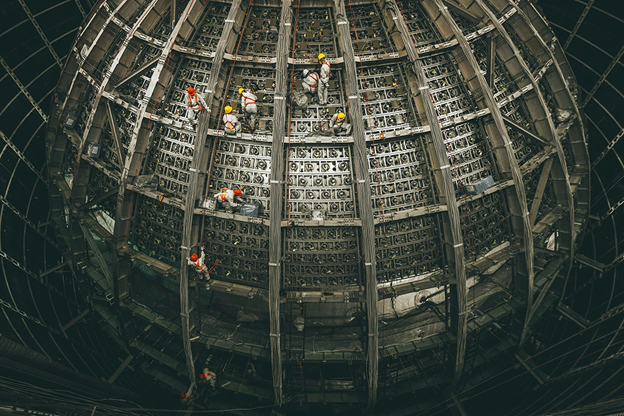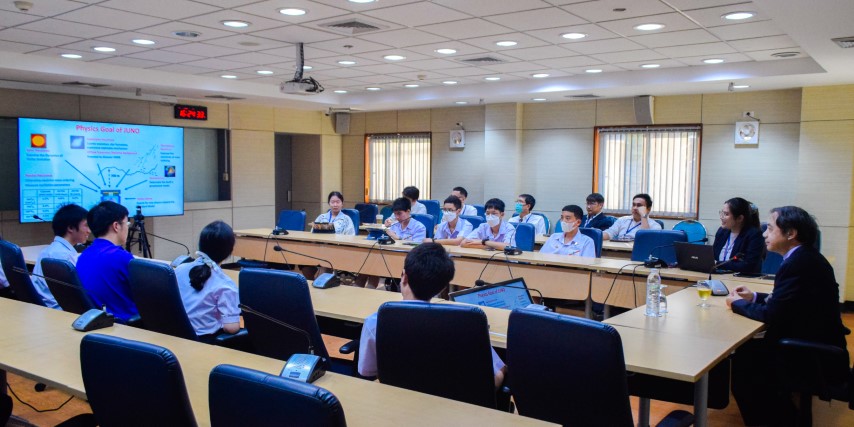Professor Wang Yifang, Jatuporn Puntree, Pranom Jitklang

Particle Physicist and Director of the Institute of High Energy Physics (IHEP) Chinese Academy of Sciences
Introduction
This special lecture was part of the International Students Science Fair 2025 (ISSF 2025), organized by Mahidol Wittayanusorn School (Public Organization). The invited speaker, Professor Wang Yifang, is a renowned particle physicist and accelerator scientist, serving as the Director of the Institute of High Energy Physics (IHEP) at the Chinese Academy of Sciences. He is widely recognized for his contributions to neutrino physics. The lecture aimed to inspire students and teachers at Mahidol Wittayanusorn School, particularly those with a keen interest in physics.
What is a Neutrino?
A neutrino is a type of fundamental particle called Lepton. There are three types of neutrinos: Electron neutrino, Muon neutrino, and Tau neutrino
Neutrinos are commonly produced in particle interactions and nuclear decay processes. For instance, in beta decay, a neutrino or an antineutrino is emitted as a byproduct. Neutrinos also originate from nuclear reactions in stars, supernova explosions, and even man-made nuclear reactors.
One of the most fascinating properties of neutrinos is their extremely weak interaction with other particles. They can pass through the entire Earth without being affected. Despite this, neutrinos play a crucial role in new physics and beyond the Standard Model physics. Neutrinos move at extremely high speeds, close to the speed of light. In a past CERN particle physics experiment, neutrinos were initially measured to be traveling faster than light, but later investigations confirmed this result was due to an experimental error.
Because neutrinos travel at extremely high speeds, for a long time scientists believed neutrinos had zero mass. However, researchers from various high-energy physics institutes discovered a phenomenon known as neutrino oscillation—a process where neutrinos can switch between their three types (electron, muon, and tau neutrinos). This discovery confirmed that neutrinos do, in fact, have mass. This groundbreaking discovery earned Takaaki Kajita (Super-Kamiokande Observatory, Japan) and Arthur B. McDonald (Sudbury Neutrino Observatory, Canada) the 2015 Nobel Prize in Physics.
The discovery that neutrinos have mass required a revision of fundamental physics theories that describe the building blocks of the universe. Since neutrinos have an incredibly small mass, their role in the origin of mass in the universe remains a significant mystery. Scientists have recently identified a crucial particle in this context: the Higgs boson. The presence of mass leads to gravitational fields, which allow fundamental particles to combine into larger structures, forming galaxies, stars, celestial bodies, the sun, the earth, and even living organisms like us.
Overview of Neutrino Research
Professor Wang Yifang has played a pivotal role in neutrino physics research, particularly in the Daya Bay Reactor Neutrino Experiment. This project discovered a new type of neutrino oscillation, which has profound implications for our understanding of matter-antimatter asymmetry in the universe. The matter-antimatter asymmetry problem is one of the biggest unsolved questions in physics. According to current theories, the Big Bang should have created equal amounts of matter and antimatter. However, observations indicate that the universe contains far more matter than antimatter—a mystery that remains unsolved.
Currently, Professor Wang Yifang is leading the Jiangmen Underground Neutrino Observatory (JUNO), a large-scale international collaboration focused on neutrino behavior. The project involves over 700 scientists from 17 countries, including Thailand.

Key Aspects Discussed
1. Neutrino Detection and Experimental Challenges
- Neutrino detectors must be located underground to reduce interference from cosmic radiation.
- The depth of the laboratory depends on the sensitivity of the detector and the level of background noise.
- Budget constraints significantly impact the design and construction of underground laboratories.
2. Measuring Neutrino Mass and Neutrino Oscillations
- Current research can measure mass differences between neutrino types, but the absolute mass of neutrinos remains unknown.
- Current research can measure mass differences between neutrino types, but the absolute mass of neutrinos remains unknown.
- Future research aims to solve the absolute neutrino mass mystery, which may take another 20 years.
3. Designing Large-Scale Experimental Projects
- The Jiangmen Underground Neutrino Observatory (JUNO) is designed to study neutrinos produced by two nuclear power plants, each located 50 km away. The experiment requires constructing a 17-meter-radius spherical tank filled with 20,000 tons of liquid scintillator, surrounded by 43,200 photomultiplier tubes (PMTs) inside. This spherical tank is placed inside a 45-meter-high cylindrical tank filled with ultrapure water, acting as a filter for unwanted particles. Moreover, the entire detector is buried 700 meters underground, allowing soil and rock layers to further filter out unwanted particles, ensuring only neutrinos reach the detector. As neutrinos pass through the liquid scintillator, they may interact with molecules, producing tiny flashes of light, which are detected and amplified by photomultiplier tubes.
- JUNO is a continuation of decades of previous research in neutrino physics.
- The location of the detector was strategically chosen, balancing scientific needs and budget constraints.
- International collaboration and funding acquisition are essential for making large-scale projects a reality.

4. The Role of Water in Neutrino Detectors
- Water is used as a radiation shielding material due to its low cost and transparency.
- It helps reduce noise from cosmic radiation and provides mechanical stability to the detector. (The water in the outer cylindrical tank serves to bear the weight and support the spherical detector.)
- Compared to the IceCube project, which focuses on studying higher-energy neutrinos from space, the JUNO project emphasizes studying neutrinos produced by nuclear reactors.
Scientific and Career Perspectives
1. Pathway into the Field of Particle Physics
- Professor Wang Yifang initially studied particle physics through accelerator experiments before transitioning to neutrino research, as it is a highly complex field that offers opportunities to work in smaller research groups. In smaller teams, researchers must take on multiple roles, allowing them to develop a broader range of skills compared to larger research groups.
- He emphasized that scientific research does not start from scratch but builds upon decades of prior research studies.
2. Challenges in Research and Overcoming Obstacles
- Large-scale physics projects face continuous technical challenges and complexities that require constant problem-solving.
- Research funding is subject to change, depending on scientists’ ability to effectively present the value of their projects to governments and funding agencies.
- Professor Wang Yifang shared experiences of overcoming engineering challenges with creative solutions.
3. Advice for Young Scientists
- Choose to study what genuinely interests you rather than focusing solely on success.
- Enjoy the research process and problem-solving rather than merely seeking awards and recognition.
- Focus on the journey of learning every day rather than just the end goal or final achievements.
- Physics is not only about grand theories like relativity and quantum mechanics but also serves as a tool to solve real-life problems.
The Future of Neutrino Research and Its Applications
- Although neutrino studies currently lack direct applications, fundamental research often leads to unexpected technological advancements (e.g., relativity theory playing a crucial role in GPS systems).
- Research on dark matter and dark energy may pave the way for new physics theories beyond the Standard Model.
- Securing funding and government support depends on scientists’ ability to effectively communicate the societal importance of their research.



Reflections and Conclusion of the Lecture
Students and teachers from Mahidol Wittayanusorn School expressed their gratitude to Professor Wang Yifang for the insights and knowledge shared in his lecture, which broadened their perspectives on fundamental physics and inspired them in their research endeavors.
Professor Wang Yifang encouraged students to be inquisitive, ask questions, and embrace the challenges of research, regardless of whether their work has immediate practical applications. The lecture concluded with group photo taking as a memento of this inspiring exchange.


